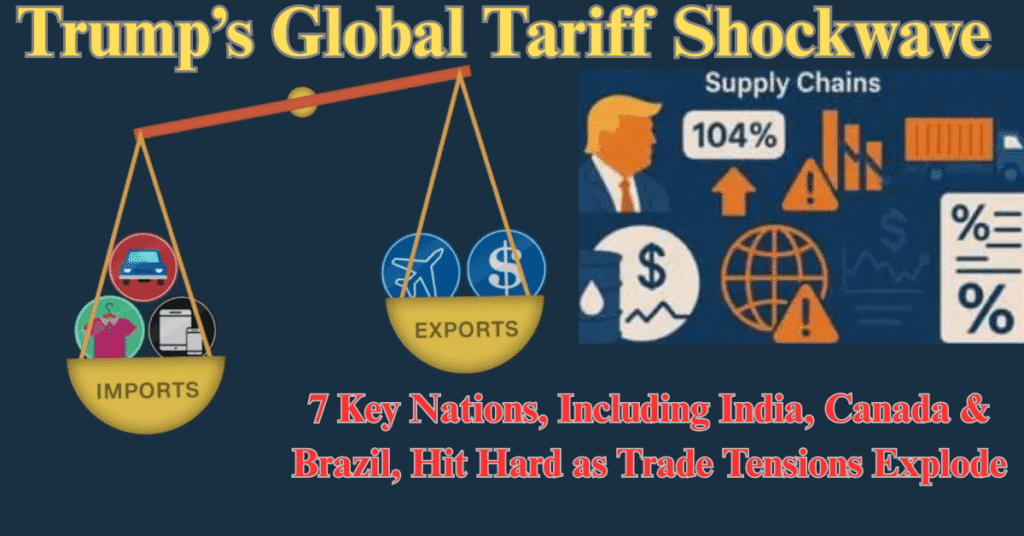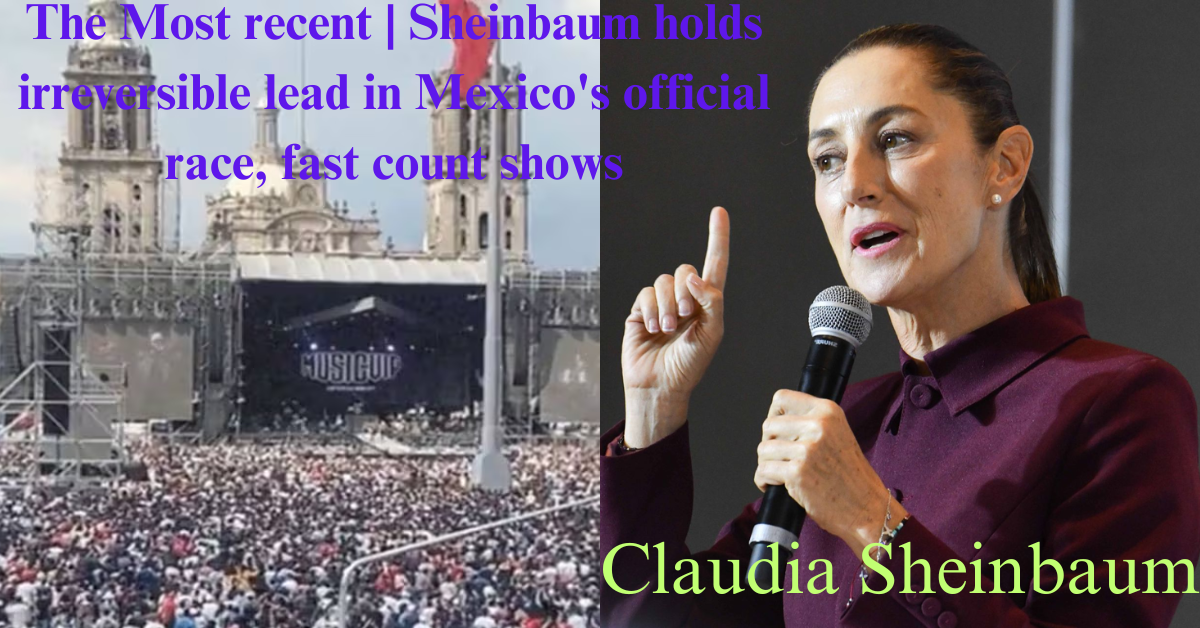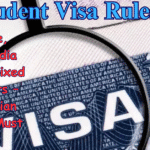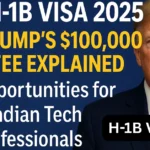
Table of Contents
Tariff
Tariff : Washington D.C., August 1, 2025 — In a move set to redefine the global trade landscape, U.S. President Donald Trump has announced a sweeping set of new import tariffs targeting 69 countries and the 27-member European Union. The executive order, signed late Thursday, will come into effect from August 7, 2025, and will cover a wide range of imported goods from electronics and automobiles to industrial metals, textiles, and consumer products.
This aggressive step comes under Trump’s “America First 2.0” economic agenda and is being described by the White House as part of a “reciprocal tariff” strategy to counter what the administration sees as unfair trade practices by U.S. partners.

📌 What the Executive Order Says
The executive order introduces a multi-tier tariff system that adjusts duties based on the existing trade relationships and historical tariffs of other countries on U.S. goods. The highlights include:
- 69 countries targeted for increased tariffs, ranging from 15% to 41%.
- Default 10% tariff for countries not listed.
- EU given conditional exemption: No tariffs on goods with existing duties over 15%, and adjusted 15% for others.
- Mexico gets a 90-day reprieve to negotiate long-term trade solutions.
🔎 Why These Tariffs Now?
The decision is the culmination of months of negotiations, trade reviews, and political messaging. Key motivations include:
- Widening U.S. trade deficit — especially with countries like Mexico ($171.5B), Vietnam, and India.
- Protection of American industries — particularly in automobiles, semiconductors, agriculture, and metals.
- Reciprocity Demand — Trump has repeatedly said many nations impose high tariffs on U.S. exports while enjoying near-zero duties on imports.
“If they charge us 25%, we’ll charge them 25%, simple as that,” President Trump said during his campaign rally in Pennsylvania.
🌍 Who Is Affected? (Tariff Highlights)
The tariffs are not uniform. They are targeted, country-specific, and based on current trade dynamics.
🔺 Countries Facing Highest Tariffs
| Country | New Tariff Rate | Reason Given |
|---|---|---|
| Syria | 41% | Political tensions and trade imbalance |
| Switzerland | 39% | Currency and trade advantage concerns |
| Laos, Myanmar | 40% | Sanctions and low import duties on U.S. goods |
| Iraq, Serbia | 35% | Regional instability, imbalance |
| Libya, Algeria | 30% | Energy and security factors |
⚠️ Key Economies Hit
| Country | Tariff Rate |
|---|---|
| India | 25% |
| Vietnam | 20% |
| Pakistan | 19% |
| Indonesia | 19% |
| Brazil | 10% |
| United Kingdom | 10% |
| South Africa | 30% |
| Turkey | 15% |
🇪🇺 European Union (Special Rules)
- Goods already taxed over 15%: Exempt
- Other items: Adjusted by -15% based on Pillar 1 rate
🇲🇽 Mexico: A 90-Day Window
After high-stakes talks between President Trump and Mexican President Claudia Sheinbaum, Mexico has secured a 90-day delay in the implementation of new tariffs.
However:
- 25% tariffs on auto imports remain unchanged.
- 50% tariffs on metals (steel, aluminum, copper) will stay.
- Mexico has agreed to remove non-tariff trade barriers, though exact details are pending.
This comes amid growing scrutiny over the USMCA (United States–Mexico–Canada Agreement), which Trump hinted may be renegotiated next year.
🌐 How the World Is Reacting
🏛️ European Union:
“While we appreciate the exemptions, we urge the U.S. to return to WTO-based rules,” said EU Trade Commissioner Annika Weber.
🇮🇳 India:
The Indian Commerce Ministry stated, “We are reviewing the full implications of this order and will engage with Washington diplomatically to ensure minimal disruption to trade.”
🇨🇳 China:
Not currently on the list, but trade experts expect tariffs may follow. Trump has long criticized China for what he calls “currency manipulation and dumping.”
📉 Global Economic Impact
📦 Supply Chain Disruption
Many companies that rely on imported components may face immediate cost spikes. Sectors most affected:
- Electronics
- Automobiles
- Steel & Metals
- Pharmaceutical Ingredients
- Agricultural Goods
💸 Rising Prices for U.S. Consumers
Analysts warn that import-dependent sectors could pass higher prices on to consumers. Everyday products like smartphones, washing machines, and packaged foods could see price increases.
🌎 Potential for Retaliation
Some nations have already started preparing counter-tariffs targeting U.S. exports such as soybeans, whiskey, and machinery.
🧠 Expert Take
“This is more than just tariffs—it’s economic leverage. Trump is using trade as a diplomatic tool,” said Jason Goldstein, Senior Trade Analyst at Brookings Institution.
“It might hurt some consumers in the short term, but Trump is banking on long-term manufacturing resurgence in the U.S.”
📈 What’s Next?
🔮 Future Scenarios
- Increased Bilateral Deals: More countries may seek fast-track negotiations to secure exemptions.
- WTO Showdown: Expect legal challenges and diplomatic protests at the WTO.
- Trade Wars 2.0: Similar to the 2018–19 tariffs, retaliation and tension may escalate.
📜 Full Country-Wise Tariff List (Sample)
| Country | Tariff % |
|---|---|
| Afghanistan | 15% |
| Bangladesh | 20% |
| Cambodia | 19% |
| India | 25% |
| Indonesia | 19% |
| Iraq | 35% |
| Japan | 15% |
| Myanmar | 40% |
| Nigeria | 15% |
| Serbia | 35% |
| South Korea | 15% |
| Sri Lanka | 20% |
| Switzerland | 39% |
| Syria | 41% |
| Taiwan | 20% |
| Thailand | 19% |
| United Kingdom | 10% |
| Vietnam | 20% |
➡️ Full list available on U.S. Trade Department portal and PDF download.
🇮🇳 India Hit With Full 25% Tariff – No Reprieve from Washington
India has been slapped with a full 25% tariff under the new U.S. order. Despite earlier signals of dialogue, no concessions were granted.
🔎 What’s Behind the Tariff on India?
President Trump cited unresolved issues over India’s agricultural import barriers and continuing energy ties with Russia as reasons. Speaking at a press conference, Trump bluntly stated:
“I don’t care what India does to Russia. They can crash their dead economies together – I don’t care.”
The timing couldn’t be worse. A U.S. trade delegation is scheduled to visit New Delhi on August 25 to restart negotiations, but the tariffs will remain in place until then.
This comes as U.S.–India trade relations were warming. India was the second-largest source of U.S. business visitors in May, with over 43,000 travelers, as per Commerce Department data.
🇨🇦 Canada Penalized with 35% Tariff Over Fentanyl Dispute
Canada, America’s second-largest trading partner, has also come under fire. In a separate executive order, tariffs on certain Canadian goods have been raised from 25% to 35%, with Trump accusing Ottawa of failing to control the flow of fentanyl into the United States.
Despite previous conversations with Canadian PM Mark Carney, Trump admitted:
“We have not spoken to Canada today.”
A senior U.S. official added, “Canadian officials have not shown as much creativity as the Mexican side.”
The decision is expected to strain U.S.–Canada trade relations, already delicate due to ongoing USMCA concerns.
🇧🇷 Brazil Retaliates After Being Hit With 50% Tariff
Brazil has emerged as one of the biggest losers in Trump’s tariff spree, facing a 50% tariff on most exports—excluding key products like aircraft, energy, and orange juice.
U.S. frustration with the prosecution of former Brazilian President Jair Bolsonaro, a known Trump ally, is believed to have played a role.
Brazil’s Finance Minister Fernando Haddad called the decision “unjust and politically motivated”, and confirmed plans to appeal or retaliate if negotiations fail.
🇰🇷 South Korea Avoids Steep Tariffs With $350B Investment Deal
Unlike others, South Korea successfully negotiated a reduction in tariffs from the expected 25% to 15%, in exchange for committing $350 billion in investments into U.S.-selected infrastructure and technology projects.
This has been hailed as a win-win by U.S. officials, though critics question the fairness of such investment-linked tariff adjustments.
🇹🇼 Taiwan Facing 20% Tariff, Yet Hopeful of a Better Deal
Taiwan, a key semiconductor supplier, is currently subject to a 20% provisional tariff, though its leadership remains optimistic.
President Lai Ching-te announced:
“The U.S. has left the door open for future reductions if we reach an agreement. Talks will continue.”
Taiwan’s government confirmed four rounds of discussions have already taken place, and both sides are working towards a resolution. The timing is crucial, especially with rising AI chip exports from the island.
🇹🇭 Thailand Welcomes 19% Tariff, Calls It “Success”
Surprisingly, Thailand responded positively to the 19% tariff, viewing it as a symbol of recognition and cooperation.
“This reflects a win-win approach,” said government spokesperson Jirayu Huangsab, adding that the deal ensures export base protection and economic stability.
🇨🇳 China’s Deadline Looms: Can a Deal Be Reached by August 12?
China, while not yet facing new tariffs, is racing against a looming deadline. According to U.S. Treasury Secretary Scott Bessant, the two nations are nearing a deal, but it’s still incomplete.
“We had a lot of resistance during this week’s talks in Stockholm. But we’re pushing hard,” Bessant said.
China has until August 12 to finalize an agreement. Failing that, further tariffs may follow.
⚖️ Legal Challenges: Are Trump’s Tariffs Constitutional?
Trump’s tariffs were imposed under the 1977 International Emergency Economic Powers Act (IEEPA), declaring a national trade emergency. However, the move is already facing judicial scrutiny:
- The U.S. Court of International Trade ruled in May 2025 that certain tariffs overstepped executive authority.
- Appellate judges echoed concerns that Trump’s use of IEEPA for trade regulation may be unconstitutional.
Legal experts predict a Supreme Court showdown, especially if more industries sue over rising costs.
💵 Impact on U.S. Consumers: Prices Are Already Rising
While Trump touts these tariffs as protection for American industries, consumers are beginning to feel the financial pinch:
📈 Price Increases in June (Commerce Dept. Data):
- Home furnishings: +1.3%
- Entertainment goods: +0.9%
- Clothing and textiles: +0.4%
Economists warn these are early indicators, and prices could surge further as the tariffs on essential goods take full effect by August 7.
🗣️ Trump Defends the Move
Despite legal pushback and diplomatic fallout, Trump remains confident:
“We’ve made some great deals today. This will benefit American workers and families in the long run.”
He declined to specify which countries had finalized favorable deals.
Will Trump’s Tariff Strategy Reshape Global Trade or Backfire?
The real test of Trump’s bold tariff campaign lies ahead. With trade talks, legal battles, consumer price hikes, and global responses unfolding in real-time, the world is watching how this policy will evolve.
🔮 Potential Outcomes:
- More bilateral deals as countries scramble to avoid high tariffs.
- Retaliatory tariffs that could lead to global trade instability.
- Legal restrictions that might eventually curb executive power.
- Long-term reshoring of industries, if Trump’s goals succeed.
For now, India, Canada, Brazil, and others will need to balance diplomacy, trade survival, and political pressure—as the countdown to August 7 continues.
🧾 Conclusion: A New Trade Order?
President Trump’s decision to impose these tariffs underscores his enduring focus on economic nationalism. While the move may bolster U.S. domestic manufacturing and address trade imbalances, it also opens the door to economic uncertainty, global tension, and supply chain instability.
With over 69 countries affected, the global economy is watching closely how this plays out in the coming months. One thing is certain: August 7, 2025, will mark the beginning of a new phase in U.S.-led trade policy.
TrumpTariffs #GlobalTradeTensions #IndiaUSRelations #BrazilTariff #CanadaFentanylCrisis #TaiwanChipExports #TradeWar2025 #USChinaTalks #TrumpEconomicPolicy #TariffImpact
Related Articles You May Like:
- 🇮🇳 India’s Exports Under Pressure: How SMEs Can Navigate U.S. Tariffs
- 🇲🇽 Mexico Gets 90-Day Reprieve from Trump Tariffs: What’s the Catch?
- ⚖️ Can Trump Legally Impose These Tariffs? A Constitutional Breakdown


